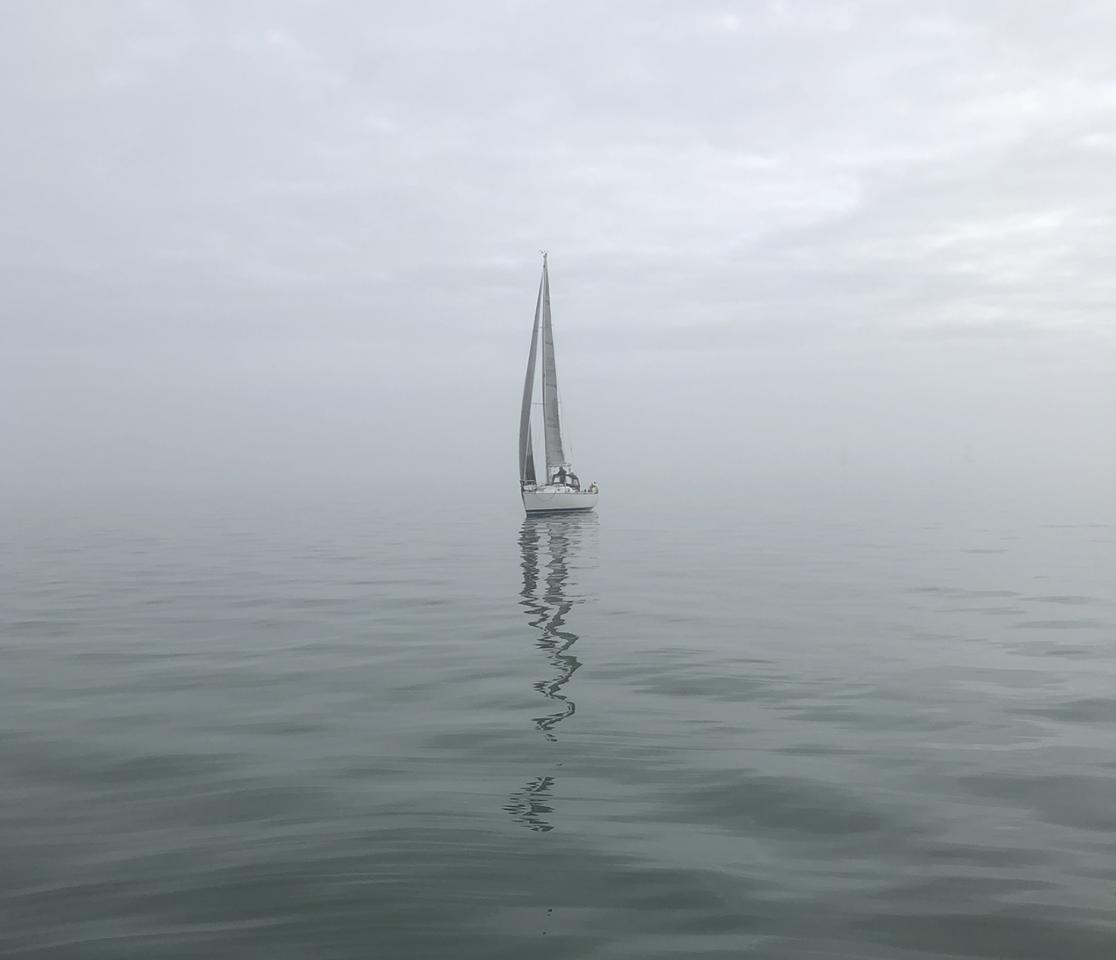
Between storm events, winter on San Francisco Bay offers some very pleasant light wind sailing, but when the wind is especially thin, getting your boat moving and keeping it moving can be a challenge that tests your patience. To effectively harness whatever breeze there may be requires some skill, focus, and practice. Here are some tips and techniques to try out next time you find yourself bobbing on the Bay in gentle breezes.
Tip 1: Trimming Sails for Light Wind
Curve and Twist
A rounded and baggy sail shape will make more use of available wind than a tight, flat sail. While your goal is to encourage a deep draft or "belly" in the sail shape, excessive bagginess in the sail will increase turbulence in the sail and reduce lifting power.
Tension mainsail halyards only to the point that the horizontal wrinkles disappear. (Note: On MSC yacths, halyard tension on roller-furling jibs and in-mast furling mainsails has been preset by MSC fleet technicians. Do not attempt to adjust.) Easing the mainsail outhaul will also contribute to a deeper draft in the sail shape.
Avoid over-trimming both the jib and mainsail. Remember the old adage – “if in doubt, let it out.” Ease the sheet until the leech of the sail luffs, then trim it in just to the point that the leech stops luffing. Trim or ease sails in small, smooth increments (centimeters or inches), as light wind takes longer to reattach to sails.
Be aware of the phenomenon of wind shear – the tendency of wind speed and/or direction to vary at different altitudes – even very small differences in altitude. In light wind, a twisting of the wind direction between the masthead and deck level tends to be more pronounced due to the effect of apparent wind. Increasing the twist in the top of the sail helps to compensate for wind shear and improve the trim up the entire height of the sail.
Look for differences in the behavior between the upper and lower tell-tales. First, the lower tell-tales on both sides of the sail should be streaming back for at least half of the time. If not, adjust either the sheet trim or your point of sail until they are. Second, look to the upper tell-tales as your guide to achieving the right amount of twist at the top of the sail. The goal is to adjust the sail twist so that the upper tell-tales behave the same as the lower tell-tales.
Adjust Jib Twist
For the jib, move the jib track car aft to reduce tension on the leech and increase twist. (Never attempt to move a jib track car when it is under a heavy load, as this may result in injury.) There is a fine line between moving the car forward to create more draft at the bottom of the sail while increasing leech tension, versus moving the car aft to flatten the foot and ease tension on the leech. It may take a few adjustments (again, in small increments) to find the ideal balance.
Adjust Mainsail Twist
Mainsail trim adjustments for sailing in light airs should focus on achieving the right amount of draft and twist while avoiding excessive bagginess of the sail shape. Once you've accomplished the ideal draft with outhaul adjustments, you can add twist by easing the boom vang and mainsheet and pulling the traveller to windward.
Tip 2: Work the Wind and Tides to Your Favor
Apparent Wind is Your Ally
When sailing in light winds, the forward momentum of your boat will supply more wind power to your sails than the true wind speed alone. Do your best to maintain whatever momentum you are able to achieve to gain the most advantage from apparent wind. (You’ll learn more about keeping your momentum in Tip 3).
Downwind sailing in light airs can be an even bigger challenge as you will lose the benefit of apparent wind. If you must sail downwind, you’ll find better results on a broad reach than a dead run. “Swooping” is a maneuver that can assist progress in a downwind direction. Steer slowly up to a beam reach to build momentum, then slowly steer away from the wind. If your speed drops off again, repeat with another swoop.
When aiming downwind, a crew member standing near the bow can "poke out" the jib with a boat hook or pole to help the jib grab those puffs of breeze, rather than just flop around.
Catch the Catspaws
Watch the water for signs of wind and be prepared to take advantage of any puffs that come your way to help build your momentum. Patches of slightly darker-colored ripples on the water, or “catspaws” are a sign that a puff of breeze is on its way. The ripples will also indicate the direction that the puff is coming from. Before the puff reaches your boat, gently steer in the direction that will make the most of your existing sail trim when the puff arrives.
Ride the Tide
Tidal currents near shore tend to be less swift than tides in deeper water. When the tidal current is against the direction you want to go, sail as close to shore as safely possible. (Important: Never sail between a buoy and shore – if you do, you will be in great danger of running aground.)
When your intended direction is going with the tidal current, your momentum will benefit by sailing in deeper water where tidal currents will flow more quickly – but watch out for shipping traffic. Start the engine if you’re becalmed in a shipping lane when a large ship is approaching. Do whatever is necessary to hastily get out of the way.
Know Where to Find Wind
Before you sail, check the weather forecast for the predicted wind direction. Bear in mind that landmasses will create a wind shadow, an area of very light or no wind on the lee side of the landmass. If the wind is coming from the southeast, north, or northeast, you'll find better wind in the South Bay, East Bay, and San Pablo Bay. If the wind is coming from the west or southwest, the Central Bay can be your best bet, although you may still find some wind far from the lee of Point Tiberon and Angel Island in the East Bay. Watch the water to follow signs of wind and dodge the wind shadows when you sail into these areas.
Tip 3: Maintain Momentum
Don’t Rock the Boat
The wake of large passing ships and powerboats can interfere with your momentum, as rocking on waves will “shake out” the wind from the sails. Avoid high traffic areas whenever possible. The same is true for sudden shifts in weight aboard. On smaller, lighter boats that tend to rock with the movement of crew, ask crew members to move slowly when shifting from one side of the boat to the other.
Minimize Drag
When steering and maneuvering, apply small, delicate movements to the helm. Oversteering the rudder will increase drag and slow the boat down.
Moving weight forward helps to reduce drag from stern wake turbulence. Have your crew sit near midship on the leeward side. While reducing drag at the stern, the heeling induced by their weight also helps to improve the foil shape of the sails by holding them to leeward.
Marine growth cluttering a hull will increase drag. All yachts in Modern Sailing's fleet have their hulls cleaned every two months, with the exception of our racers Kele, Kokomo, and Phoenix, which are cleaned monthly. You can be assured that aboard an MSC yacht, clingy crud won't slow you down in light wind conditions.
Ready to learn even more advanced light wind sailing and sail trim techniques? You’ll gain new skills, get your questions answered, and enjoy plenty of hands-on practice with a highly knowledgeable Modern Sailing instructor by joining our Light Wind Sailing Techniques and Mastering Sail Trim Clinics. If long-distance cruising plans are on your horizon, learn how to harness light wind on downwind points of sail with an asymmetrical spinnaker in our Mastering Asymmetrical Spinnaker for Cruisers Clinic.
Article by Mary Elkins on January 13, 2021


